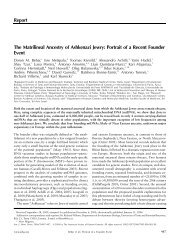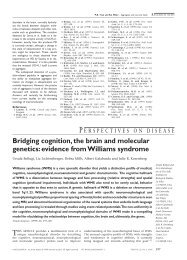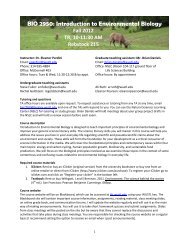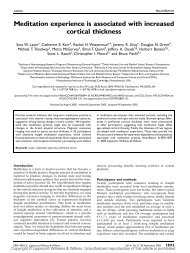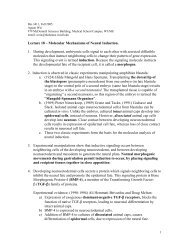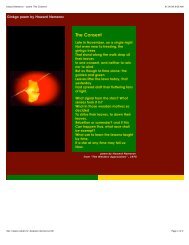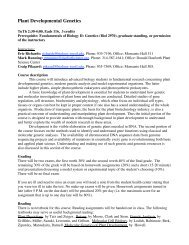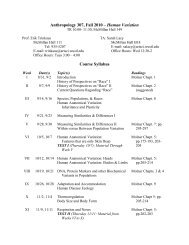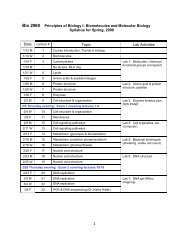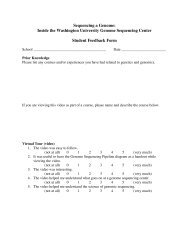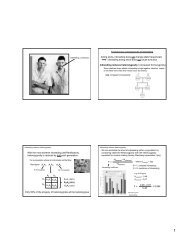Benito-Gutierrez & Arendt 2009
Benito-Gutierrez & Arendt 2009
Benito-Gutierrez & Arendt 2009
You also want an ePaper? Increase the reach of your titles
YUMPU automatically turns print PDFs into web optimized ePapers that Google loves.
Current Biology Vol 19 No 15<br />
R642<br />
Saccoglossus is a transitory feature that<br />
may correspond to the larval nervous<br />
system of other enteropneusts.<br />
This work opens up new avenues of<br />
comparative CNS research. Clearly,<br />
these data, together with the inverted<br />
BMP patterning in acorn worms [17],<br />
are consistent with the view that the<br />
neural plate of the proboscis stem, the<br />
collar cord, the circumesophageal tract<br />
and ventral cord together correspond<br />
to the chordate CNS as a whole and to<br />
the CNS of other invertebrates where<br />
inversion has not occurred, as<br />
proposed earlier [16]. Yet, a more<br />
detailed comparative picture still<br />
remains to be drawn. So far, knowledge<br />
of neuron types in enteropneusts and<br />
of their differential distribution is rather<br />
scarce and will require a much closer<br />
inspection of a larger number of<br />
neuronal markers. Also, a link with the<br />
detailed orthologous gene expression<br />
data in vertebrates, similar to that<br />
described for Saccoglossus [14], will<br />
have to be established. Only then will it<br />
be possible to firmly homologise any<br />
portion of the enteropneust CNS with<br />
that of chordates or even annelids<br />
or arthropods. As a start, the<br />
concentration of GABAergic neurons in<br />
the proboscis stem, apparently located<br />
at the interface between the six3 and otx<br />
territory [14], may correspond to<br />
GABAergic populations in the vertebrate<br />
[18] and in the annelid forebrain (R.<br />
Tomer and D.A., unpublished results).<br />
If indeed the CNS represents ancient<br />
bilaterian heritage and vertebrates<br />
inverted their DV axis, one prominent<br />
problem still remains, as discussed by<br />
Brunet and colleagues [5] (Figure 2):<br />
The dorsal portions of the enteropneust<br />
CNS are located exactly where the<br />
chordates would have evolved their<br />
(new) mouth — on their new ventral<br />
(formerly dorsal) body side now facing<br />
the substrate. How can we reconcile<br />
this Dohrn [4] had suggested that the<br />
new chordate mouth evolved from the<br />
ventral relocation of gill slits (Figure 2),<br />
as is suggested by the amphioxus<br />
mouth, which is thought to represent<br />
a ventrally shifted gill slit [19] — hence<br />
the name Branchiostoma, meaning ‘gill<br />
slit mouth’. Interestingly, a strand of<br />
neurogenic tissue has recently been<br />
discovered along the amphioxus<br />
ventral midline giving rise to scattered<br />
neuronal precursors that further<br />
migrate dorsally [20] before the mouth<br />
takes its place. Future molecular<br />
comparisons of the neuronal cell types<br />
involved will reveal whether this<br />
transitory neurogenic ventral strand<br />
in amphioxus might be related to the<br />
dorsal strand of neurons in acorn<br />
worms or rather represents an<br />
independent acquisition that either<br />
could be an apomorphy or could be<br />
related to a second wave of<br />
centralisation: namely the dorsal<br />
reunion of a primitive neuronal<br />
population with placode-neural crest<br />
characteristics. With these new insights<br />
derived from mud- and sand-living<br />
acorn worms, comparative research on<br />
chordate nervous system evolution<br />
appears more exciting than ever.<br />
References<br />
1. Romer, A.S. (1972). The vertebrate as a dual<br />
animal - somatic and visceral. Evol. Biol. 6,<br />
121–156.<br />
2. Garstang, W. (1894). Preliminary note on a new<br />
theory of the ancestry of the Chordata. Zool.<br />
Anz. 17, 122–125.<br />
3. Geoffroy St.-Hilaire, E. (1822). Considérations<br />
générales sur la vertèbre. Mém. Mus. Hist. Nat.<br />
9, 89–119.<br />
4. Dohrn, A. (1875). Der Ursprung der Wirbelthiere<br />
und das Princip des Functionswechsels<br />
(Leipzig: Verlag von Wilhelm Engelmann).<br />
5. Nomaksteinsky, M., Röttinger, E., Dufour, H.D.,<br />
Chettouh, Z., Lowe, C.J., Martindale, M.Q., and<br />
Brunet, J.-F. (<strong>2009</strong>). Centralization of the<br />
deuterostome nervous system predates<br />
chordates. Curr. Biol. 19, 1264–1269.<br />
6. <strong>Arendt</strong>, D., and Nübler-Jung, K. (1994).<br />
Inversion of dorsoventral axis Nature 371, 26.<br />
7. <strong>Arendt</strong>, D., and Nübler-Jung, K. (1999).<br />
Comparison of early nerve cord development<br />
in insects and vertebrates. Development<br />
126, 2309–2325.<br />
8. Denes, A.S., Jekely, G., Steinmetz, P.R.,<br />
Raible, F., Snyman, H., Prud’homme, B.,<br />
Ferrier, D.E., Balavoine, G., and <strong>Arendt</strong>, D.<br />
(2007). Molecular architecture of annelid nerve<br />
cord supports common origin of nervous system<br />
centralization in bilateria. Cell 129, 277–288.<br />
9. Holley, S.A., Jackson, P.D., Sasai, Y., Lu, B.,<br />
De Robertis, E.M., Hoffmann, F.M., and<br />
Ferguson, E.L. (1995). A conserved system for<br />
dorsal-ventral patterning in insects and<br />
vertebrates involving sog and chordin. Nature<br />
376, 249–253.<br />
10. Duboc, V., Rottinger, E., Lapraz, F.,<br />
Besnardeau, L., and Lepage, T. (2005).<br />
Left-right asymmetry in the sea urchin embryo<br />
is regulated by nodal signaling on the right side.<br />
Dev. Cell 9, 147–158.<br />
11. Hibino, T., Nishino, A., and Amemiya, S. (2006).<br />
Phylogenetic correspondence of the body axes<br />
in bilaterians is revealed by the right-sided<br />
expression of Pitx genes in echinoderm larvae.<br />
Dev. Growth Differ. 48, 587–595.<br />
12. Delsuc, F., Brinkmann, H., Chourrout, D., and<br />
Philippe, H. (2006). Tunicates and not<br />
cephalochordates are the closest living<br />
relatives of vertebrates. Nature 439, 965–968.<br />
13. Cannon, J.T., Rychel, A.L., Eccleston, H.,<br />
Halanych, K.M., and Swalla, B.J. (<strong>2009</strong>).<br />
Molecular phylogeny of hemichordata, with<br />
updated status of deep-sea enteropneusts.<br />
Mol. Phylogenet. Evol. 52, 17–24.<br />
14. Lowe, C.J., Wu, M., Salic, A., Evans, L., Lander, E.,<br />
Stange-Thomann, N., Gruber, C.E., Gerhart, J.,<br />
and Kirschner, M. (2003). Anteroposterior<br />
patterning in Hemichordates and the origins of<br />
the chordate nervous system. Cell 113,853–865.<br />
15. Holland, N.D. (2003). Early central nervous<br />
system evolution: an era of skin brains Nat.<br />
Rev. Neurosci. 4, 1–11.<br />
16. Nübler-Jung, K., and <strong>Arendt</strong>, D. (1996).<br />
Enteropneusts and chordate evolution.<br />
Curr. Biol. 6, 352–353.<br />
17. Lowe, C.J., Terasaki, M., Wu, M.,<br />
Freeman, R.M., Jr., Runft, L., Kwan, K.,<br />
Haigo, S., Aronowicz, J., Lander, E., Gruber, C.,<br />
et al. (2006). Dorsoventral patterning in<br />
hemichordates: insights into early chordate<br />
evolution. PLoS Biol. 4, e291.<br />
18. Sugino, K., Hempel, C.M., Miller, M.N.,<br />
Hattox, A.M., Shapiro, P., Wu, C., Huang, Z.J.,<br />
and Nelson, S.B. (2006). Molecular taxonomy of<br />
major neuronal classes in the adult mouse<br />
forebrain. Nat. Neurosci. 9, 99–107.<br />
19. Conklin, E.G. (1932). The embryology of<br />
amphioxus. J. Morph. 54, 69–118.<br />
20. <strong>Benito</strong>-<strong>Gutierrez</strong>, E., Nake, C., Llovera, M.,<br />
Comella, J.X., and Garcia-Fernandez, J. (2005).<br />
The single AmphiTrk receptor highlights<br />
increased complexity of neurotrophin signalling<br />
in vertebrates and suggests an early role in<br />
developing sensory neuroepidermal cells.<br />
Development 132, 2191–2202.<br />
Developmental Biology Unit, European<br />
Molecular Biology Laboratory, D-69117<br />
Heidelberg, Germany.<br />
*E-mail: arendt@embl.de<br />
DOI: 10.1016/j.cub.<strong>2009</strong>.06.020<br />
Cancer: CINful Centrosomes<br />
The regulation of centrosome number is lost in many tumors and the presence<br />
of extra centrosomes correlates with chromosomal instability. Recent work<br />
now reveals how extra centrosomes cause chromosome mis-segregation<br />
in tumor cells.<br />
Samuel F. Bakhoum<br />
and Duane A. Compton*<br />
Centrosomes are pivotal organizers<br />
of the microtubule cytoskeleton and<br />
their duplication and inheritance is<br />
strictly controlled during the cell cycle<br />
in a manner that parallels genome<br />
duplication [1]. This control is lost<br />
in many cancer cells, making the<br />
presence of extra centrosomes<br />
a discernible feature of many tumors<br />
[2]. This defect has long been<br />
associated with aneuploidy in cancer<br />
and it is postulated that additional<br />
centrosomes induce chromosome<br />
mis-segregation, which then<br />
contributes to tumorigenesis [3–6].



